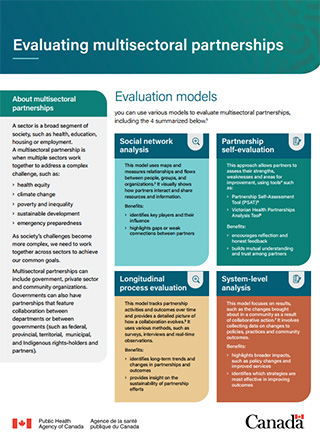Evaluating multisectoral partnerships
Download in PDF format
(338 KB, 2 pages)
Organization: Public Health Agency of Canada
Date published: March 2025
About multisectoral partnerships
A sector is a broad segment of society, such as health, education, housing or employment. A multisectoral partnership is when multiple sectors work together to address a complex challenge, such as:
- health equity
- climate change
- poverty and inequality
- sustainable development
- emergency preparedness
As society’s challenges become more complex, we need to work together across sectors to achieve our common goals.
Multisectoral partnerships can include government, private sector and community organizations. Governments can also have partnerships that feature collaboration between departments or between governments (such as federal, provincial, territorial, municipal, and Indigenous rights-holders and partners).
Evaluation models
You can use various models to evaluate multisectoral partnerships, including the 4 summarized below.Footnote 1
Social network analysis
This model uses maps and measures relationships and flows between people, groups, and organizations.Footnote 2 It visually shows how partners interact and share resources and information.
Benefits:
- identifies key players and their influence
- highlights gaps or weak connections between partners
Partnership self-evaluation
This approach allows partners to assess their strengths, weaknesses and areas for improvement, using toolsFootnote 3 such as:
- Partnership Self-Assessment Tool (PSAT)Footnote 4
- Victorian Health Partnerships Analysis ToolFootnote 5
Benefits:
- encourages reflection and honest feedback
- builds mutual understanding and trust among partners
Longitudinal process evaluation
This model tracks partnership activities and outcomes over time and provides a detailed picture of how a collaboration evolves.Footnote 6 It uses various methods, such as surveys, interviews and real-time observations.
Benefits:
- identifies long-term trends and changes in partnerships and outcomes
- provides insight on the sustainability of partnership efforts
System-level analysis
This model focuses on results, such as the changes brought about in a community as a result of collaborative action.Footnote 7 It involves collecting data on changes to policies, practices and community outcomes.
Benefits:
- highlights broader impacts, such as policy changes and improved services
- identifies which strategies are most effective in improving outcomes
Health in All Policies Approach
The Health in All Policies approach considers the health implications of policies and decisions.Footnote 8 It brings sectors together to:
- seek synergies
- avoid harm
- improve health equity
Multisectoral partnerships can help sectors make progress on shared goals by:
- identifying and developing solutions for common policy issues
- fostering a culture of collaboration, and
- leveraging resources
Why evaluate multisectoral partnerships
Evaluations can improve collaboration by helping partners improve:
- Accountability: ensures all partners are contributing to shared goals
- Effectiveness: measures the success of partnerships in achieving its objectives
- Quality: identifies areas for improvement for partnerships
- Sustainability : assesses long-term sustainability and impact
In short, evaluation can help build trust and communication among partners, and support them in better understanding each others’ goals, areas of expertise, and challenges. No matter which method is used, evaluation helps improve multisectoral collaborations for equitable health and wellbeing outcomes.
References
- Footnote 1
-
Asirvatham R, Nelson A, Northam J, Lucyk K. Methods for Evaluation Intersectoral Action Partnerships to Address the Social Determinants of Health: A Scoping Review. HPCDPJ 2024.
- Footnote 2
-
Leppin, A. L., Okamoto, J. M., Organick, P. W., Thota, A. D., Barrera-Flores, F. J., Wieland, M. L., McCoy, R. G., Bonacci, R. P., & Montori, V. M. (2018). Applying Social Network Analysis to Evaluate Implementation of a Multisector Population Health Collaborative That Uses a Bridging Hub Organization. Frontiers in public health, 6, 315.
- Footnote 3
-
Gutmanis, I., & Hillier, L. M. (2018). Geriatric Cooperatives in Southwestern Ontario: A novel way of increasing inter-sectoral partnerships in the care of older adults with responsive behaviours. Health & social care in the community, 26(1), e111–e121.
- Footnote 4
-
Center for the Advancement of Collaborative Strategies in Health. (2002). Partnership self-assessment tool questionnaire.
- Footnote 5
-
Victorian Health Promotion Foundation. (2016). The Partnerships Analysis Tool.
- Footnote 6
-
Riggs, E., Block, K., Warr, D., & Gibbs, L. (2014). Working better together: new approaches for understanding the value and challenges of organizational partnerships. Health promotion international, 29(4), 780–793.
- Footnote 7
-
Collie-Akers, V. L., Fawcett, S. B., & Schultz, J. A. (2013). Measuring progress of collaborative action in a community health effort. Revista panamericana de salud publica = Pan American journal of public health, 34(6), 422–428.
- Footnote 8
-
World Health Organization. Working together for equity and healthier populations: Sustainable multisectoral collaboration based on Health in All Policies approaches. Geneva: WHO, 2023.
